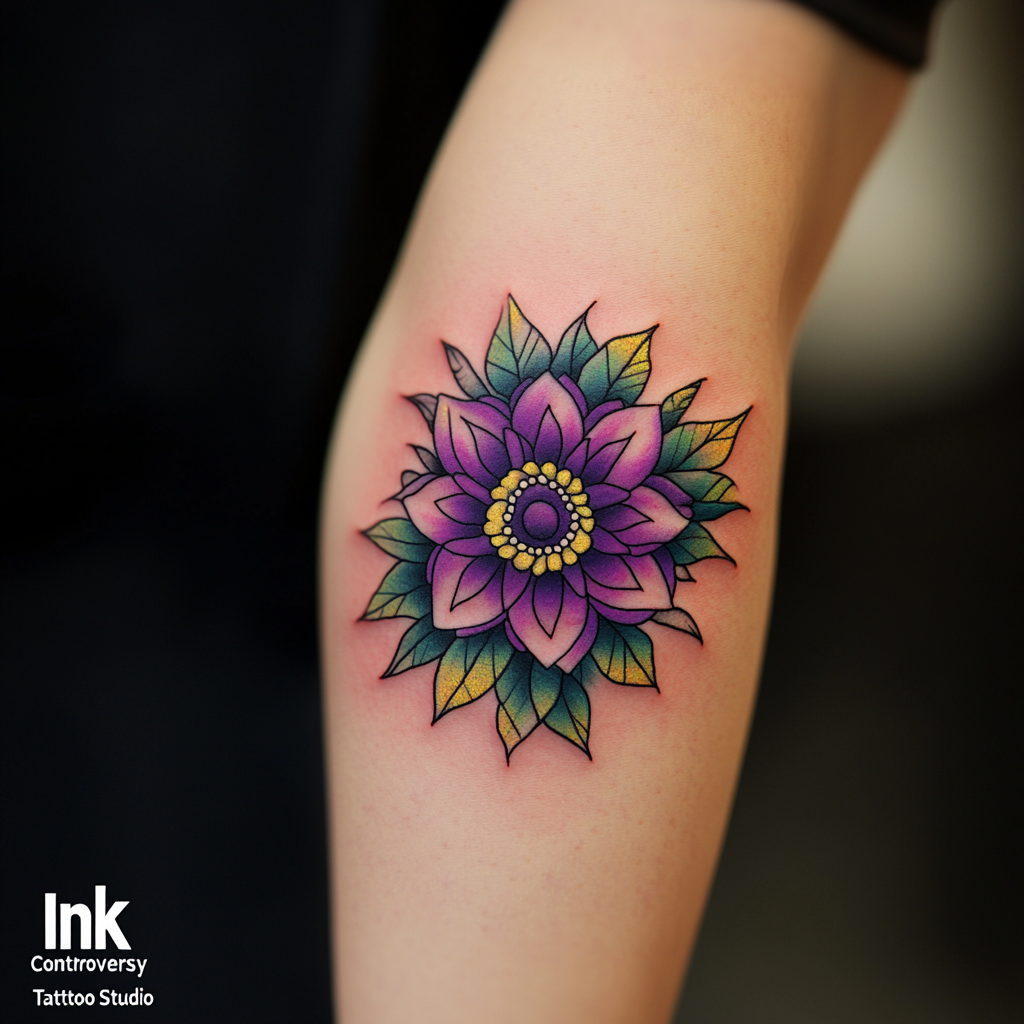If you buy through links on our site, we may earn a small affiliate commission to help support the blog - at no extra cost to you. It never influences our product selection process. Thank you!
Wondering if vibrant, detailed tattoos are possible on darker skin tones? You’re not alone. Despite common misconceptions, stunning tattoos can absolutely flourish on black and brown skin when approached with the right knowledge and expertise.
The key lies in understanding how tattoo ink interacts with melanin-rich skin. While certain considerations exist, an experienced artist will guide you through selecting bold colors that complement your natural tone. Black, red, and green inks often create striking results, though your options aren’t limited to these. With proper technique and design selection, your tattoo can be just as detailed and expressive as any other.
Understanding Tattoos on Dark Skin: Myths vs. Reality

Melanin and Tattoo Visibility
Melanin plays a crucial role in how tattoos appear on darker skin tones. When ink is injected into the skin, it’s viewed through multiple translucent layers, and the amount of melanin affects the visibility of the finished design. It’s helpful to view melanin not as a canvas but as a tint that influences how colors appear. The higher melanin content in darker skin may retain ink differently, making some colors appear softer or more muted after healing.
Common Misconceptions Debunked
Many misconceptions about tattoos on dark skin discourage both artists and clients from exploring creative possibilities. The most common myth is that tattoos don’t appear well on darker skin, which simply isn’t true. Having more melanin in your skin isn’t an impediment to getting beautiful tattoos—it just requires proper planning and design consideration. With the right approach, tattoos on darker skin tones can lead to exceptional outcomes.
Color Considerations for Dark Skin
Colors do behave differently on melanin-rich skin. During the healing process, skin grows back on top of the tattoo, potentially overshadowing or diluting lighter colors. This means that colors may end up more muted on darker tones, but this doesn’t mean vibrant tattoos aren’t possible. Choosing inks with higher vibrancy and focusing on contrast and saturation can create stunning results. Black, red, and green inks typically show up well on dark skin, offering excellent starting points for your tattoo ideas.
Techniques for Successful Tattooing
Tattooing darker skin requires refined techniques to ensure optimal results. Artists should use a delicate approach, avoiding overworking the skin which can increase the risk of scarring and keloid formation. Employing techniques like softer pressure and fewer passes helps mitigate potential skin damage. The goal is to achieve vibrancy and longevity in the tattoo without compromising skin health. Expert tattoo artists understand these considerations and adapt their approach accordingly.
Working with an Experienced Artist
Finding an artist experienced in working with darker skin tones is essential for successful tattoos. These professionals understand the unique challenges and opportunities presented by melanin-rich skin. They’ll help you select designs and colors that complement your natural skin tone while ensuring the tattoo remains visible and vibrant over time. Don’t hesitate to ask artists about their experience with dark skin and to see examples of their work on similar skin tones.
Best Tattoo Styles for Dark Skin Tones
Certain tattoo styles naturally complement darker skin tones by utilizing techniques that enhance visibility and longevity. These styles emphasize contrast, bold lines, and designs that work with the natural beauty of melanated skin.
Bold Blackwork Designs

Bold blackwork designs are among the most striking tattoo styles for dark skin tones. These tattoos feature strong, thick lines and solid black ink that creates excellent contrast against melanated skin. Geometric patterns, tribal designs, and mandala artwork particularly shine on darker complexions because they rely on clean lines and negative space rather than color variation. The bold linework ensures your tattoo remains visible and defined even as it ages, making this style both aesthetically pleasing and practical for long-term wear. Consider large-scale blackwork pieces that incorporate meaningful cultural symbols or abstract designs that allow your natural skin tone to become part of the artistic expression.
Realistic Portrait Tattoos

Realistic portrait tattoos can be breathtaking on dark skin when executed by the right artist. The key to successful portraits lies in the contrast—skilled artists use black and gray shading techniques with strategic highlights to create dimension and depth. When considering portrait tattoos, look for artists who specifically showcase examples of their work on skin tones similar to yours. These tattoos often work best on larger areas of the body where the details can be properly spaced out. Family portraits, celebrity likenesses, or historical figures can be immortalized with impressive realism when the artist understands how to manipulate shadows and highlights on darker skin. The result is a captivating, three-dimensional piece that honors both the subject and your skin tone.
Neo-Traditional Approaches

Neo-traditional tattoo styles offer an excellent option for dark skin by combining bold outlines with a more modern color palette specifically selected to pop against melanated skin. This style features slightly thicker lines than traditional American tattoos while incorporating vibrant colors like deep reds, rich blues, and forest greens that show up beautifully on darker complexions. Neo-traditional designs often include flora, fauna, and symbolic elements with a distinctive illustrative quality. The slightly exaggerated proportions and stylized appearance of neo-traditional work create visual impact that translates well to darker skin tones. For the most striking effect, choose designs with high contrast and minimal fine details, allowing the bold colors and clean lines to make a statement that will remain vivid for years to come.
Color Theory: Which Inks Work Best on Dark Skin
Understanding color theory is essential when planning tattoos on dark skin. The right ink choices can make your tattoo pop with vibrancy and ensure it remains visible for years to come.
High-Contrast Color Combinations
Color selection is crucial for tattoos on darker skin tones. The melanin in your skin acts as a tint over your tattoo, affecting how colors appear once healed. Deep, bold colors create the most striking tattoos on melanated skin by providing necessary contrast.
Deep blue tattoos stand out beautifully against darker skin tones, offering rich visibility and lasting power. Crimson and red inks also show up remarkably well, creating vibrant designs that complement the warmth in darker complexions. Deep purple is another excellent choice that maintains its intensity and creates stunning visual impact.
For maximum visibility, experienced artists recommend bold colors that are darker than your natural skin tone. Black, red, and green inks typically work best, though the exact shades that will complement your skin depend on your specific undertones. Some artists perform color tests in discreet areas to determine how different inks will appear on your skin after healing.
Avoid pale or light colors like yellow, which may disappear on dark skin after healing. Instead, opt for designs that incorporate strong contrast and bold lines to enhance visibility and definition. Remember that colors will appear different on your skin than they do on paper, so viewing examples of healed tattoos on similar skin tones can help set realistic expectations.
The Truth About White Ink on Dark Skin
White ink tattoos present unique challenges on darker skin tones. Contrary to popular belief, white ink doesn’t stay white on any skin tone—it tends to fade and change color over time. On darker skin, this process happens even faster, with white ink often fading almost immediately after healing.
According to industry experts, white ink appears through the “lens” of your melanin, making it difficult to achieve the bright, crisp look often seen in white ink tattoo photos (which are typically shown on lighter skin). The white ink ends up looking like a subtle scar or takes on a yellowish or beige appearance as it heals.
If you’re determined to incorporate white ink in your tattoo design, consider using it sparingly as highlights within a larger, bolder design rather than as the primary color. Simple designs with bold lines work better than intricate patterns when using white ink. Some artists may suggest alternative approaches, such as leaving negative space or using colors that will complement your skin tone while achieving a similar aesthetic effect.
Always consult with an artist who has extensive experience with darker skin tones before committing to a white ink design. They can show you realistic examples of how white ink has healed on skin tones similar to yours, helping you make an informed decision that will result in a tattoo you’ll love for years to come.
10 Stunning Tattoo Ideas for Dark Skin
Geometric Patterns

Geometric tattoos create striking visual impact on dark skin with their bold lines and precise angles. The clean, structured nature of geometric designs provides excellent contrast against melanated skin tones. Consider getting sacred geometry patterns like mandalas, honeycomb structures, or triangle compositions that incorporate thick, defined lines to ensure longevity. Dotwork geometric designs with substantial spacing between elements allow your skin to breathe while maintaining clarity as the tattoo ages. The abstract nature of geometric tattoos means they can be personalized with elements that hold special meaning while still maintaining their high-contrast appeal that works beautifully on darker skin.
Script and Typography

Bold lettering and stylized typography make for powerful tattoos on dark skin that remain legible and striking over time. When choosing script tattoos, opt for larger sizing and spacing between letters to prevent blurring as the tattoo ages. Thick, substantial fonts like blackletter or bold sans-serif styles create necessary contrast against deeper skin tones. Consider meaningful quotes, names, or dates rendered in a size that allows proper healing without the lines bleeding together. Many skilled artists specialize in typography for dark skin and can recommend specific techniques like adding shadows or highlights that enhance readability while complementing your natural skin tone beautifully.
Floral Designs

Floral tattoos on dark skin can be absolutely breathtaking when designed with bold outlines and strategic color choices. Opt for flowers with distinct, simple shapes like roses, lotus flowers, or sunflowers that won’t lose definition over time. Artists who specialize in tattoos on dark skin often recommend using deep reds, rich purples, and forest greens that stand out beautifully against melanated skin. Consider designs with negative space between petals to create contrast and clarity. Bold line work framing the florals ensures the design remains crisp and visible, while traditional or neo-traditional styling with thicker outlines helps maintain the integrity of the design as it ages on your skin.
Cultural Symbols

Cultural symbols make meaningful and visually striking tattoos that celebrate heritage while complementing darker skin tones. African symbols like Adinkra from Ghana or Egyptian ankhs utilize bold, simple lines that maintain visibility and significance on melanated skin. Traditional tribal patterns from cultures worldwide often feature thick black lines and geometric elements that create excellent contrast. Consider symbols that represent your personal heritage rendered in a size that allows for proper detail without overcrowding. When done by artists experienced with dark skin, these cultural tattoos not only look stunning but also serve as powerful expressions of identity and connection to your roots.
Celestial Motifs

Celestial tattoos featuring moons, stars, and planets create magical contrast on dark skin with their bold shapes and cosmic symbolism. Stars and crescent moons with thick outlines pop beautifully against melanated skin, especially when designed with adequate negative space between elements. Consider designs that incorporate deep blues and purples for planets or galaxies, colors that complement darker skin tones while creating visible dimension. For added impact, combine celestial elements with geometric patterns or dotwork that creates texture without requiring fine details that might blur. Night sky scenes with bold stars and simplified constellations work particularly well, creating a stunning visual effect that enhances your natural skin tone.
Animal Silhouettes

Animal silhouettes offer bold, distinctive designs that stand out wonderfully on dark skin. The simplified, solid black approach creates maximum contrast while avoiding the need for fine details that might not heal as clearly. Lions, panthers, wolves, and birds of prey are particularly striking choices that maintain their powerful presence on melanated skin. Consider placement on larger body areas like the back, chest, or thigh to allow the silhouette ample space to make its impact. Some artists enhance these designs with minimal highlight work or subtle texture techniques that add dimension without compromising visibility, resulting in a tattoo that celebrates both the beauty of your skin and the majesty of the animal depicted.
Abstract Blackwork

Abstract blackwork tattoos utilize solid black ink to create striking visual contrast that’s particularly effective on darker skin tones. These designs embrace bold shapes, negative space, and artistic expression without relying on fine details that might blur over time. Consider flowing abstract patterns, brush-stroke effects, or contemporary art-inspired pieces that use varying line weights and solid fills. The beauty of abstract blackwork is its versatility – your design can be completely unique while still working harmoniously with your skin tone. This style often ages exceptionally well on dark skin since it doesn’t rely on color retention, making it both a visually stunning and practical choice for long-lasting tattoo art.
Dotwork Mandalas

Dotwork mandalas create mesmerizing patterns on dark skin through strategic placement of dots that form intricate designs. The technique involves using dots with adequate spacing rather than fine lines, which helps prevent blurring over time on melanated skin. These spiritual symbols represent harmony and unity while providing visually captivating body art. When created with proper spacing between dots and sections, these designs maintain their clarity and impact as they age. Consider larger mandala designs placed on the back, chest, or thigh to allow for proper detailing without overcrowding. The contrast between the black ink dots and your natural skin tone creates a dimensional effect that’s both subtle and striking.
Bold Traditional

Traditional tattoo styles adapted for dark skin focus on simplified designs with heavy outlines and strategic color choices. Classic motifs like roses, daggers, and anchors work beautifully when rendered with thicker lines and bolder proportions than traditionally used. Deep reds, rich blues, and forest greens complement darker skin tones while maintaining visibility over time. Consider designs that incorporate ample negative space between elements to enhance contrast and prevent details from blurring together. This style honors traditional tattooing while making technical adjustments that ensure the design thrives on melanated skin, resulting in tattoos that are both timeless and tailored specifically to enhance your natural beauty.
Ornamental Patterns

Ornamental tattoos featuring elements from henna, mehndi, and decorative arts create elegant, flowing designs that beautifully complement dark skin. These patterns typically use bold black lines arranged in lace-like configurations that create striking contrast against melanated skin. Consider ornamental bands around the wrist, arm, or ankle, or larger statement pieces that frame parts of the body like the sternum or shoulder blade. When designed with adequate spacing between the intricate elements, these tattoos maintain their clarity and visual impact as they age. The symmetrical, flowing nature of ornamental patterns creates a harmonious look that enhances your natural skin tone while providing sophisticated, timeless body art that reflects cultural artistry and personal elegance.
Placement Considerations for Maximum Impact
Choose Less Sun-Exposed Areas
Selecting less sun-exposed areas for your tattoos ensures better color retention on dark skin. Areas like your inner arm, thigh, chest, or back typically experience less sun damage than forearms or shoulders. Since UV exposure fades tattoos faster on all skin tones, placing your art on protected areas helps preserve vibrant colors longer. This is especially important for darker skin where maintaining contrast is crucial for visibility.
Opt for Naturally Lighter Skin Tones
Your body naturally has variation in skin tone, with some areas being slightly lighter than others. Consider placing colorful tattoo designs on the inner arm, inner thigh, or stomach where your skin may be a shade lighter. These areas often provide better contrast for your tattoo, allowing colors to appear more vibrant against your skin. Artists experienced with dark skin tones can help identify optimal placement zones where your design will show up best.
Consider Visibility and Size Together
When designing tattoos for dark skin, the size and visibility work hand-in-hand. Larger designs with adequate space between lines and elements create better definition on darker skin tones. As one tattoo expert notes, “The thing that works about tattoos is contrast. Otherwise, from a distance it just looks like a blob.” Avoid cramming too much detail into small spaces—instead, allow your design room to breathe with sufficient negative space between elements.
Strategically Use Body Contours
The natural contours of your body can enhance tattoo visibility on dark skin. Placing designs on slightly curved areas like the upper arm, shoulder blade, or hip can help accentuate the tattoo’s dimensions through natural light and shadow play. This strategic placement helps create natural contrast that makes your tattoo pop more effectively, particularly for designs with bold lines and geometric elements.
Balance Private vs. Public Visibility
Consider how often you want your tattoo to be visible when choosing placement. Inner arm or thigh placements not only offer better color retention but also provide the option to keep your tattoo private or display it selectively. For dark skin specifically, these less-exposed areas maintain their color longer and typically experience less stretching and fading over time, preserving the integrity of detailed designs.
Aftercare Tips Specific to Dark Skin
Keep It Clean and Moisturized
Proper cleansing is essential for tattoos on dark skin. Wash your new tattoo gently with fragrance-free, antibacterial soap 2-3 times daily during the first week. Pat—don’t rub—the area dry with a clean paper towel. Apply a thin layer of recommended moisturizer or tattoo-specific balm to keep the skin hydrated. Melanin-rich skin can sometimes appear ashy when dry, which affects how your tattoo looks, so consistent moisturizing is crucial for maintaining vibrant colors and clear lines.
Avoid Sun Exposure
Sun exposure is particularly damaging to tattoos on darker skin tones. UV rays can cause premature fading and color distortion, which is especially problematic when you’ve carefully selected colors that complement your melanated skin. Always cover fresh tattoos completely when outdoors, and once healed, apply a broad-spectrum sunscreen with SPF 30 or higher specifically formulated for tattoos. Remember that even with darker skin, UV protection is essential for preserving your tattoo’s longevity and vibrancy.
Watch for Hyperpigmentation
Darker skin tones are more susceptible to post-inflammatory hyperpigmentation after tattooing. Monitor your healing tattoo for any unusual darkening of the skin surrounding the tattooed area. If you notice hyperpigmentation developing, don’t panic—it’s often temporary. Continue with your aftercare routine and consult your tattoo artist or a dermatologist if the discoloration persists beyond the normal healing period. Using gentle, non-irritating products helps minimize this risk.
Be Cautious with Exfoliation
While exfoliation is part of normal skin care, be extra cautious with newly healed tattoos on dark skin. Harsh scrubs can cause micro-tears that lead to hyperpigmentation or uneven healing. Wait at least 4-6 weeks after your tattoo has completely healed before introducing any exfoliation to your routine. When you do begin exfoliating, use gentle chemical exfoliants rather than physical scrubs, and limit the frequency to once weekly to maintain your skin’s integrity and your tattoo’s appearance.
Monitor for Keloid Formation
Dark skin has a higher tendency to develop keloids—raised scars that can distort tattoo designs. During the healing process, keep a close eye on how your skin is responding. Normal healing involves some scabbing and flaking, but if you notice raised, thick tissue forming, consult your tattoo artist or dermatologist promptly. If you’ve developed keloids from previous injuries, inform your tattoo artist beforehand so they can adjust their technique to minimize trauma to your skin.
Use Products Formulated for Dark Skin
Select aftercare products specifically formulated for darker skin tones. These products often contain ingredients that address hyperpigmentation concerns while providing appropriate moisture levels. Avoid products containing hydroquinone, harsh alcohols, or fragrance, as these can irritate darker skin and cause uneven healing. Look for natural ingredients like aloe vera, cocoa butter, and vitamin E, which support healing without causing irritation or disrupting melanin production.
Document the Healing Process
Take photos of your tattoo throughout the healing process to track how colors settle into your skin tone. This documentation helps you understand how different inks appear on your specific skin tone as they heal, which is valuable knowledge for future tattoos. Compare the freshly done tattoo with photos taken at 1 week, 2 weeks, 1 month, and 3 months. This visual record can help you communicate more effectively with artists for future tattoo projects on your dark skin.
Be Patient with Color Development
Colors in tattoos on darker skin often take longer to reach their final appearance. What might look somewhat muted immediately after healing can develop more character over time as your skin fully integrates the ink. Give your tattoo at least 4-6 weeks to settle before making any judgments about the final result. This patience is particularly important with tattoos that incorporate colors like deep blues, reds, and purples that are recommended for dark skin tones.
Celebrities with Amazing Tattoos on Dark Skin
Looking for tattoo inspiration? These celebrities with dark skin showcase stunning ink that might inspire your next piece:
Rihanna’s Stars and Constellation
Rihanna’s neck and back constellation tattoo demonstrates how stellar designs create striking contrast on dark skin. The cascading star pattern flows beautifully down her spine, proving that simple black designs can make a powerful statement. Her collection also includes script work and small symbolic pieces that maintain clarity and definition years after application.
Kelly Rowland’s Symbolic Ink
Kelly Rowland sports several meaningful tattoos, including script on her foot reading “God’s Gift.” The bold, clean lettering stands out perfectly against her skin tone, demonstrating how well-executed typography can create stunning contrast on darker skin. Her choices show how personal mantras and meaningful phrases make for timeless tattoos with depth.
Angelina Theresa’s Floral Designs
As a tattoo model and influencer, Angelina Theresa showcases how vibrant floral designs can thrive on dark skin. Her botanical tattoos feature bold outlines with strategic color choices that maintain visibility and impact. Her portfolio demonstrates how skilled artists can create dimensional floral work that complements melanin-rich skin beautifully.
Lena Waithe’s Statement Pieces
Writer and actress Lena Waithe displays thoughtfully placed tattoos that complement her style. Her visible arm pieces feature strong linework and designs that maintain clarity and definition. Her tattoo choices exemplify how cultural symbols and geometric patterns can be incorporated into meaningful body art that enhances rather than competes with dark skin tones.
FKA Twigs’ Artistic Expression
FKA Twigs embraces tattoos as extensions of her artistic persona. Her collection includes delicate yet visible line work placed strategically across her body. Her tattoos demonstrate how abstract patterns and symbolic imagery can be adapted to complement darker skin while maintaining their artistic integrity and visibility.
2 Chainz’s Bold Statements
2 Chainz showcases how traditional black ink work creates maximum impact on dark skin. His large-scale pieces feature strong outlines and solid black fills that maintain their definition and visibility. His tattoo collection is a testament to how classic designs with proper sizing allow details to remain distinct against melanated skin.
Kehlani’s Diverse Collection
Singer Kehlani’s extensive tattoo collection showcases various styles that work beautifully on darker skin. From mandala-inspired patterns to script work, their tattoos demonstrate the versatility possible with proper technique. Their strategic placement choices maximize visibility while creating a cohesive overall aesthetic that flows with their natural skin tone.
Jourdan Dunn’s Elegant Minimalism
Model Jourdan Dunn’s tattoos prove that simple designs can make a powerful statement on dark skin. Her collection includes small, strategically placed pieces with clean lines and thoughtful placement. Her tattoo choices demonstrate how minimalist designs can create elegant body art that enhances rather than overwhelms your natural beauty.
Jordan Peele’s Cultural Homage
Director Jordan Peele sports tattoos that honor his heritage and passions. His arm pieces show how cultural symbols and meaningful imagery can be translated into bold tattoo designs that maintain clarity on darker skin. His tattoos serve as inspiration for those looking to incorporate personal heritage into their body art.
Willow Smith’s Symbolic Pieces
Willow Smith’s delicate yet visible tattoos demonstrate how spiritual and symbolic imagery can work beautifully on dark skin. Her geometric designs and meaningful symbols showcase the importance of proper line weight and spacing to ensure longevity and visibility on melanated skin.
Conclusion: Embracing Your Unique Canvas
Your dark skin is a beautiful canvas waiting for the right artist and design to showcase its natural elegance. Armed with knowledge about color theory placement and aftercare you’re now ready to make informed choices about your body art journey.
Remember that finding an artist who specializes in melanated skin is non-negotiable. Take your time exploring portfolios asking questions and discussing your vision before committing to any design.
The growing gallery of stunning tattoos on dark-skinned celebrities and everyday people proves that vibrant detailed art is absolutely achievable. Trust the process celebrate your unique canvas and wear your chosen design with pride. Your perfect tattoo awaits!
Frequently Asked Questions
Can you get vibrant tattoos on dark skin?
Yes, vibrant tattoos are absolutely possible on darker skin tones. With the right artist who understands how ink interacts with melanin-rich skin, stunning and detailed tattoos can thrive on black and brown skin. The key is selecting bold colors that complement your natural skin tone and working with an artist experienced in tattooing darker skin.
What colors work best for tattoos on darker skin?
Bold, rich colors with high contrast work best on darker skin. Deep blues, crimsons, and deep purples provide excellent visibility and lasting power. Black, red, and green inks are particularly effective. Avoid pale colors like yellow or pastel shades as they tend to fade quickly and may not show up well against melanated skin.
Should I avoid white ink on dark skin?
White ink typically doesn’t achieve the bright appearance many expect on darker skin tones. It tends to fade quickly and often takes on a slightly yellowish or translucent appearance as it heals. Instead of using white for large areas, consider using it sparingly as highlights within larger designs or consult with an artist who specializes in dark skin tattooing.
What tattoo styles are most effective on dark skin?
Bold blackwork with strong lines and solid black ink creates excellent contrast on dark skin. Neo-traditional styles with bold outlines and vibrant colors also work well. Geometric patterns, dotwork mandalas, and ornamental designs can be stunning when properly executed. Realistic portraits can be effective when done by artists who understand how to manipulate shadows and highlights on darker skin.
How do I find a tattoo artist experienced with dark skin?
Look for artists whose portfolios include work on diverse skin tones, especially healed tattoo photos. Check for strong line work, appropriate color selection, and good contrast in their work. Artists who tag clients of various skin tones on social media are often more experienced. During consultations, ask directly about their experience with darker skin and request to see examples of healed work.
Does tattooing hurt more on dark skin?
No, skin tone does not affect pain levels during tattooing. Pain sensitivity depends on factors like placement, individual pain tolerance, and the tattoo technique being used. However, some artists may need to adjust their technique slightly for darker skin, which might feel different but not necessarily more painful.
Where should I place my tattoo for maximum visibility on dark skin?
Choose areas with less sun exposure like inner arms or thighs to maintain color vibrancy. Consider naturally lighter areas of your skin for colorful designs, as they provide better contrast. Larger designs with adequate spacing between details prevent muddling over time. Strategic use of body contours can enhance visibility, and areas with thinner skin often show tattoo details more clearly.
What special aftercare is needed for tattoos on dark skin?
Keep the tattoo clean and moisturized with products formulated for dark skin. Avoid sun exposure to prevent fading and color distortion. Monitor for hyperpigmentation, which can be more common in darker skin. Be cautious with exfoliation around the tattoo area. Document the healing process, as colors may take longer to settle into their final appearance on melanated skin.
Can darker skin tones get color tattoos?
Absolutely. While certain pale colors may not show up well, a wide range of vibrant colors can create stunning tattoos on darker skin. Deep blues, reds, purples, and greens can create beautiful contrast against melanated skin when applied by a knowledgeable artist using proper techniques for dark skin.
Do tattoos fade faster on dark skin?
Not necessarily. Tattoo longevity depends more on aftercare, sun exposure, and the quality of the application than on skin tone. However, certain colors may appear to fade more quickly on darker skin if not properly applied. Working with an artist experienced in tattooing dark skin and following proper aftercare will help ensure your tattoo remains vibrant for years







